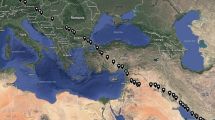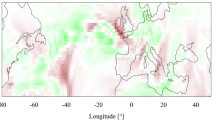Abstract
This chapter presents a contrail mapping algorithm developed for integration into a Multi-objective Trajectory Optimisation (MOTO) software framework, targeting the mitigation of environmental impacts associated with aviation-induced cloudiness. The presented linear contrail mapping algorithm exploits analytical and empirical models to determine the formation, persistence and radiative properties of contrails along a defined flight trajectory . In order to determine the contrail formation and persistence, the algorithm takes into account aircraft characteristics as well as relative humidity, temperature, pressure as well as the speed and shear of winds aloft, derived from suitable weather forecast data inputs. The linear contrail mapping algorithm generates an accurate mapping of the contrail persistence and associated Radiative Forcing (RF) along a flight trajectory based on inputs of weather data and aircraft state. A 3D contrail mapping algorithm is developed by executing the linear contrail mapping algorithm along an arbitrary number of virtual sounding trajectories. These virtual trajectories are constructed radially around a centre position, at individual flight levels. Multiple 3D mappings are exploited to characterise time variations, ultimately leading to a 4-dimensional (4D) mapping in space and time of contrail formation, persistence and RF properties. These 4D contrail mappings can be exploited in a MOTO software framework to assess and minimise the environmental impacts associated with contrails.
Access this chapter
Tax calculation will be finalised at checkout
Purchases are for personal use only
Similar content being viewed by others
References
Atlas D, Wang Z, Duda DP (2006) Contrails to cirrus—Morphology, microphysics, and radiative properties. J Appl Meteorol Climatol 45:5–19. doi:10.1175/JAM2325.1
Burkhardt U, Kärcher B (2011) Global radiative forcing from contrail cirrus. Nat Clim Change 1:54–58
E Team (2015), ESRL Global Monitoring Division—GRAD Group. Available: http://www.esrl.noaa.gov/gmd/grad/solcalc/sollinks.html, 7 May 2015
European ATM Master Plan—The roadmap for sustainable air traffic management, SESAR JU, Brussels, Belgium, 2012
Flightpath 2050: Europe’s vision for aviation—Report of the high level group on aviation research. European Commission—Directorate General for Mobility and Transport, Luxemburg, 2011
Galindo AAS, Candelario K (2011) Next generation air transportation system (NextGen)
Gardi A, Sabatini R, Ramasamy S, Kistan T (2014) Real-time trajectory optimisation models for next generation air traffic management systems. Appl Mech Mater 629:327–332. doi:10.4028/www.scientific.net/AMM.629.327
Gardi A, Sabatini R, Kistan T, Lim Y, Ramasamy S (2015) 4-Dimensional trajectory functionalities for air traffic management systems. In: Proceedings of integrated communication, navigation and surveillance conference (ICNS 2015), Herndon, VA, USA. doi:10.1109/ICNSURV.2015.7121246
Gierens K, Jensen E (1998) A numerical study of the contrail-to-cirrus transition. Geophys Res Lett 25(23):4341–4344. doi:10.1029/1998gl900151
Kärcher B, Peter T, Biermann U, Schumann U (1996) The initial composition of jet condensation trails. J Atmos Sci 53:3066–3083. doi:10.1175/1520-0469(1996)053
Kärcher B, Burkhardt U, Unterstrasser S, Minnis P (2009) Factors controlling contrail cirrus optical depth. Atmos Chem Phys 9:6229–6254. doi:10.5194/acp-9-6229-2009
Lee DS, Fahey DW, Forster PM, Newton PJ, Wit RC, Lim LL et al (2009) Aviation and global climate change in the 21st century. Atmos Environ 43:3520–3537
Lewellen DC, Lewellen WS (2001) The effects of aircraft wake dynamics on contrail development. J Atmos Sci 58:390–406
Lim Y, Gardi A, Sabatini R (2015) Modelling and evaluation of aircraft contrails for 4-dimensional trajectory optimisation. SAE technical paper 2015-01-2538. doi:10.4271/2015-01-2538
Minnis P (2003) Contrails. In: Encyclopedia of atmospheric sciences, pp. 509–520
Myhre G, Stordal F (2001) On the tradeoff of the solar and thermal infrared radiative impact of contrails. Geophys Res Lett 28:3119–3122. doi:10.1029/2001gl013193
NOAA (2015) NOMADS—NOAA Operational Model Archive and Distribution System. Available: http://nomads.ncep.noaa.gov/, 14 May 2015
Oberthür S (2003) Institutional interaction to address greenhouse gas emissions from international transport: ICAO, IMO and the Kyoto Protocol. Clim Policy 3:191–205
Organization for nctoolbox development (2015). Available: https://github.com/nctoolbox, 11 May 2015
Ramasamy S, Sabatini R, Gardi A, Kistan T (2014) Next generation flight management system for real-time trajectory based operations. Appl Mech Mater 629:344–349. doi:10.4028/www.scientific.net/AMM.629.344
Reda I, Andreas A (2008) Solar position algorithm for solar radiation applications. National Renewable Energy Laboratory (NREL), US Dept of Energy NREL/TP-560-34302, Golden, CO, USA
Rogers RR (1976) A short course in cloud physics. A. Wheaton & Co.
Sabatini R, Gardi A, Ramasamy S, Kistan T, Marino M (2015) Modern avionics and ATM systems for green operations. In: Blockley R, Shyy W (eds) Encyclopedia of aerospace engineering, ch. eae1064. Wiley, New York
Schumann U (2012) A contrail cirrus prediction model. Geosci Model Dev 5:543–580. doi:10.5194/gmd-5-543-2012
Schumann U, Graf K, Mannstein H (2011) Potential to reduce the climate impact of aviation by flight level changes. In: 3rd AIAA atmospheric and space environments conference, AIAA paper, vol 3376, pp 1–22. doi:10.2514/6.2011-3376
Schumann U, Mayer B, Graf K, Mannstein H (2012) A parametric radiative forcing model for contrail cirrus. J Appl Meteorol Climatol 51:1391–1406. doi:10.1175/jamc-d-11-0242.1
SESAR and the Environment (2010) SESAR joint undertaking—European Commission, Brussels, Belgium
Soler M, Zou B, Hansen M (2014) Flight trajectory design in the presence of contrails: application of a multiphase mixed-integer optimal control approach. Transp Res Part C Emerg Technol 48:172–194. doi:10.1016/j.trc.2014.08.009
Sonntag D (1994) Advancements in the field of hygrometry. Meteorol Z 3:51–66
Sridhar B, Ng H, Chen N (2011) Aircraft trajectory optimization and contrails avoidance in the presence of winds. J Guid Control Dyn 34:1577–1584. doi:10.2514/1.53378
Sussmann R, Gierens KM (2001) Differences in early contrail evolution of two-engine versus four-engine aircraft: Lidar measurements and numerical simulations. J Geophys Res 106(D5), 4899. doi:10.1029/2000jd900533
Unterstrasser S, Gierens K, Spichtinger P (2008) The evolution of contrail microphysics in the vortex phase. Meteorol Z 17:145–156. doi:10.1127/0941-2948/2008/0273
Veness C (2015) Movable type scripts. Available: http://www.movable-type.co.uk/scripts/latlong.html, 25 March 2015
Zou B, Buxi GS, Hansen M (2013) Optimal 4-D aircraft trajectories in a contrail-sensitive environment. Netw Spat Econ. doi:10.1007/s11067-013-9210-x
Author information
Authors and Affiliations
Corresponding author
Editor information
Editors and Affiliations
Rights and permissions
Copyright information
© 2016 Springer International Publishing Switzerland
About this chapter
Cite this chapter
Lim, Y., Gardi, A., Marino, M., Sabatini, R. (2016). Modelling and Evaluation of Persistent Contrail Formation Regions for Offline and Online Strategic Flight Trajectory Planning. In: Karakoc, T., Ozerdem, M., Sogut, M., Colpan, C., Altuntas, O., Açıkkalp, E. (eds) Sustainable Aviation. Springer, Cham. https://doi.org/10.1007/978-3-319-34181-1_21
Download citation
DOI: https://doi.org/10.1007/978-3-319-34181-1_21
Published:
Publisher Name: Springer, Cham
Print ISBN: 978-3-319-34179-8
Online ISBN: 978-3-319-34181-1
eBook Packages: EnergyEnergy (R0)




